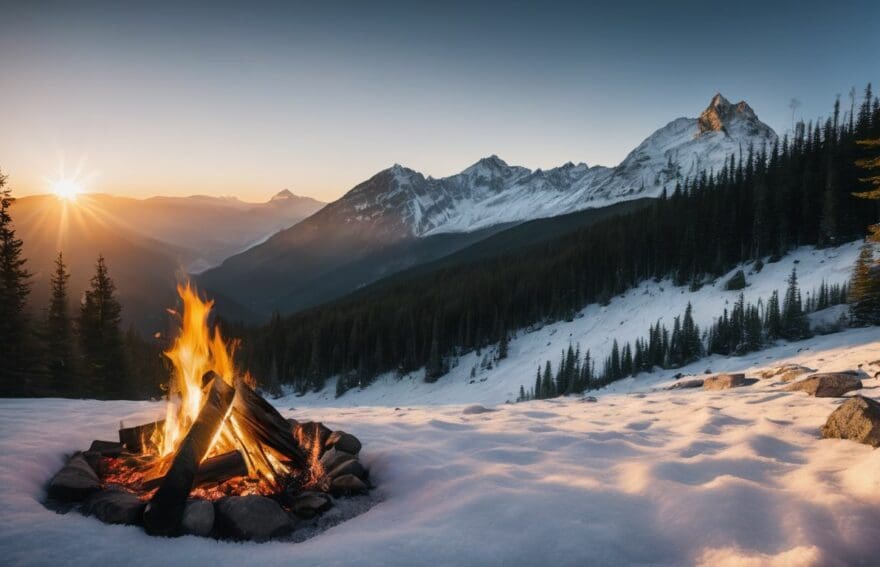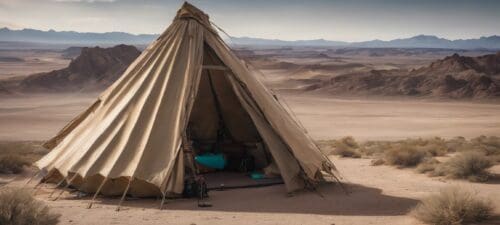Heat: Surviving the Harsh Frontier Life

Updated On: November 18, 2025 by 
Winter on the frontier was a truly formidable adversary, with cold snaps that could chill one to the bone. We’ve all felt that icy shiver penetrating the walls of our log cabins, empathising with those historical pioneers who had no choice but to wrap up in layers and sturdy cloaks to ward off the biting frosts.
Our article delves into indispensable strategies for overcoming both the piercing frost and the oppressive heat, assuring you that your endurance in virtual landscapes can reflect the steadfast spirit of those early trailblazers.
So do fetch your digital scarf – there’s an enthralling adventure just around the corner!
The Harsh Conditions of Frontier Life
The harsh conditions of frontier life pose threats of cold, illness, and starvation. It is necessary for pioneers to be prepared for the challenges they may face in order to survive.
Threats of cold, illness, starvation
We face a relentless battle against the elements when we talk about frontier living, especially during the long, merciless winters. Without cloaks, scarves, boots, and gloves, pioneers risked the biting cold seeping into their bones.
Log cabins offered little comfort from freezing temperatures that threatened every moment spent outside.
Illnesses spread quickly with few doctors around to help. We must recognise how crucial it was for families to huddle under down comforters and behind thick curtains just to survive another night.
Starvation loomed as a constant spectre; hunting diminished in winter months and if stores ran out or crops failed – hunger became all too real.
Let’s not forget these hardships; they teach us resilience in the face of adversity. Our ancestors built warmer homes as soon as they could because survival wasn’t just about enduring – it was about adapting and overcoming each threat they faced on this harsh frontier life.
Necessity of preparedness
Surviving the harsh frontier life necessitates thorough preparedness. Pioneers faced dangers such as cold, illness, and starvation during winter. Immigrant farmers in the West had to adapt to new farming techniques due to the challenging conditions of the frontier.
Furthermore, extreme heat strained the electric grid and created life-threatening blackouts.
The key is planning ahead. Staying warm with appropriate clothing and stockpiling necessary supplies is crucial for surviving harsh winters on the American frontier. Moreover, working together as a community can help mitigate challenges and turn them into opportunities for collective survival.
Essential Survival Tips for Winter on the Frontier
During winter on the frontier, it’s crucial to stay warm and stockpile necessary supplies for survival. Working together as a community can also make a huge difference in overcoming the challenges of harsh weather conditions.
Stay warm
To stay warm during the harsh winters of frontier life, pioneers wore cloaks, scarves, boots, and gloves. Families used down comforters and thick curtains to keep themselves warm in cold weather.
The threat of cold, illness, and starvation loomed large during winter seasons. As a community, they worked together to build warmer and more comfortable homes as soon as possible.
The heat in the American frontier strained the electric grid and made blackouts a life or death issue for settlers. Heat was not just an inconvenience but also posed significant dangers in their daily lives.
Stockpile necessary supplies
To stay warm in the harsh conditions of frontier life, it’s crucial to stockpile necessary supplies. This means having a sufficient supply of firewood, food, and other essentials to last through extreme winters or heatwaves.
Immigrant farmers in the West had to find new ways of farming due to harsh winter conditions while pioneers built warmer and more comfortable homes as soon as they could. These historical examples highlight the importance of anticipating and preparing for challenging weather by stocking up on essential supplies well in advance.
Proper preparation can make all the difference between survival and struggle when facing unpredictable weather patterns. Down comforters, thick curtains, cloaks, scarves, boots, gloves are just some examples from history illustrating how people stayed warm during cold times.
Work together as a community
To survive on the frontier, it’s essential to work together as a community. Pioneers often faced harsh conditions and unpredictable weather, making cooperation vital for survival. By pooling resources and sharing knowledge, settlers could better prepare for the challenges of winter and extreme heat.
In times of need, communities came together to provide support, whether it was through sharing food supplies or building shelters. This collective effort not only increased the chances of survival but also fostered a sense of unity among pioneers facing the unforgiving frontier.
By working as a community, pioneers were able to tackle immediate challenges such as severe winters and scorching summers more effectively. Together they built stronger defenses against weather-related threats and formed bonds that helped sustain them through difficult times.
Turn challenges into opportunities
Working together as a community is vital in overcoming the challenges of frontier life. Despite the harsh conditions, pioneers were able to turn their struggles into opportunities for growth and innovation.
The need to stay warm led to improvements in clothing and home construction, while unpredictable weather patterns spurred advancements in farming techniques. These challenges also fostered a sense of solidarity, encouraging settlers to support each other through mutual aid and resource sharing.
The extreme climate forced pioneers to become resilient problem solvers, developing new skills and technologies that ultimately shaped the future of frontier life. As game experts and novices alike, understanding how these difficulties were transformed into opportunities can provide valuable insight into survival strategies within the virtual world or real-life scenarios.
The Dangers of Heat in Frontier Life
The dangers of heat in frontier life are often overlooked, with record-breaking temperatures posing a serious threat to survival. Find out how pioneers adapted and survived in the harsh climate.
Record-breaking temperatures
Surviving extreme heat on the frontier required resilience and resourcefulness. As temperatures soared, pioneers had to find innovative ways to stay cool and hydrated. In such conditions, lack of fear towards excessive heat often led to life-threatening situations for individuals unprepared for the scorching climate.
Reckoning with these record-breaking temperatures became a harsh reality for those living in the wilderness.
Adapting to extreme heat on the American frontier demanded significant changes in daily life. From altering farming techniques to dealing with unpredictable rainfall patterns and challenges posed by grass-covered sod, pioneers faced an array of obstacles due to soaring temperatures.
Lack of fear towards heat
– Record-breaking temperatures have become a common occurrence, but as pioneers, we developed a lack of fear towards heat. This was our everyday reality and forced us to adapt quickly.
We found ways to survive the scorching heat through innovative techniques such as building houses with shade structures, using natural cooling methods like cross-ventilation, and strategically planting trees for shade.
Water conservation also became crucial during extreme heatwaves, and we learned to collect and store water efficiently.
– Our approach towards extreme heat involved utilisation of practical skills and resourcefulness. By creating underground cellars or digging wells in search of cooler ground temperatures, we were able to combat the relentless heat.
Adapting to Extreme Heat in the West
Changes in farming techniques and the use of unpredictable rainfall and grass-covered sod as challenges has led to the need for adaptation on the frontier. To find out more about how to survive harsh frontier life, keep reading!
Changes in farming techniques
Pioneers in the American West had to adapt their farming techniques to survive harsh conditions. They learned to cultivate drought-resistant crops and mastered dry farming methods, like planting deep to reach moisture.
These strategies helped them sustain crops with limited water supply and unpredictable rainfall, ensuring their survival in extreme weather.
Furthermore, they also embraced new irrigation methods such as furrow and flood irrigation, allowing them to bring water directly to their crops in drier regions. By diversifying their agricultural practices and using different crop rotations, settlers were able to maximise yield even during challenging climates.
Unpredictable rainfall and grass-covered sod as challenges
Adapting to extreme heat in the West brought about changes in farming techniques, but unpredictable rainfall and grass-covered turf posed equally formidable challenges. The arid conditions meant that water was scarce, making it essential to find innovative ways to conserve and utilise this precious resource effectively.
Additionally, the tough and fibrous nature of the grass-covered turf made ploughing a daunting task for farmers. Despite these obstacles, frontier settlers persevered with remarkable resilience, developing inventive farming methods that propelled them towards success in the unforgiving environment.
The Long-Term Effects of Ignoring Climate Change on Frontier Life
Climate change will lead to unpredictable weather patterns, making survival on the frontier even more challenging. To learn more about how to survive the harsh conditions of frontier life, read our full blog post!
Predicted comfortable lives and peaceful deaths for those who profited
Pioneers who wisely adapted to the challenges of harsh conditions, like extreme heat in the West and brutal winters, saw comfortable lives and peaceful deaths. Those who efficiently farmed through unpredictable rainfall or took advantage of abundant grass-covered sod thrived.
Immigrant farmers who embraced new techniques for farming also profited. Similarly, pioneers who built warmer homes with thick curtains and down comforters found comfort during cold winters.
Additionally, settlers who supported one another in stockpiling essential supplies ensured survival during harsh conditions on the frontier. By working together as a community, they created opportunities for growth and safety.
Conclusion
In conclusion, surviving the harsh frontier life requires resilience and resourcefulness. Communities must work together to adapt to extreme temperatures and changing conditions. Adapting to climate change will be crucial for ensuring a sustainable future on the frontier.
FAQs
1. What does “Heat: Surviving the Harsh Frontier Life” mean?
“Heat: Surviving the Harsh Frontier Life” refers to how frontier pioneers managed to stay alive in tough, often cold wilderness conditions by finding and maintaining sources of heat.
2. Why is heat important for winter survival in the wilderness?
Heat is crucial for winter survival as it helps prevent hypothermia and frostbite, allowing people living in harsh environments to keep warm and cook food.
3. What survival skills did frontier pioneers need?
Frontier pioneers needed a range of survival skills, including building shelters, starting fires for warmth and cooking, hunting or gathering food, and knowing how to find clean water.
4. Can you die from lack of heat on the frontier?
Yes, without proper preparation and knowledge on generating heat during extreme cold temperatures, one could suffer from “heat death,” where the body loses more heat than it can produce leading to fatal outcomes.









